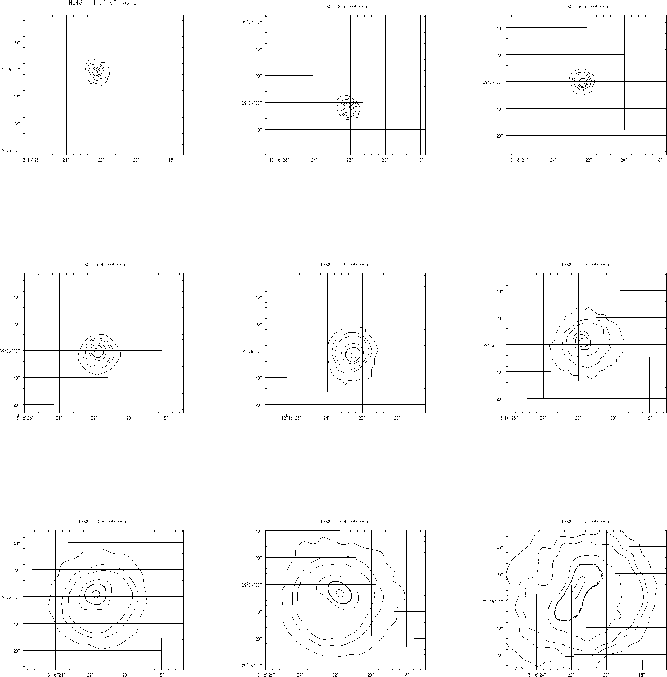| About ROSAT |
ROSAT Home Page | ROSAT Images |
|---|
The spatial resolution of the HRI off-axis
is dominated by the
XRT PSF which degrades rapidly with increasing off-axis angle.
Figures 5.7
and
5.8
display several off-axis pointings of HZ 43 and LMC X-1 and
illustrate how the images change with off-axis angle.
Figure 5.9
shows contours of the HZ 43 images.
The images were first smoothed with a gaussian filter with
![]() (
( ![]() ),
),
![]() (
( ![]() ), and
), and
![]() (
( ![]() ).
These images show that the PSF starts to degrade beyond 5' off-axis.
Beyond 12' off-axis, the images become very asymmetrical.
A central ``bar'' in the images well off-axis is perpendicular
to a line connecting the optical axis and the image centroid.
).
These images show that the PSF starts to degrade beyond 5' off-axis.
Beyond 12' off-axis, the images become very asymmetrical.
A central ``bar'' in the images well off-axis is perpendicular
to a line connecting the optical axis and the image centroid.

Figure 5.9: Contour plots of the H 43 images. The contours
are at 1, 5, 10, 30, 50, and 90% of the peak value,
with the 50% contour level shown in bold.

Figure 5.10: The 50% power radius in images of H 43, LMC X-1,
and AR Lac as a function of angle off-axis.
The parametric expression given in the text
is also shown for comparison.
The 50% power radius was determined for a series of off-axis pointings of HZ 43, AR Lac, and LMC X-1. The asymmetry at large angles has been ignored and the 50% power radius has been computed from radial binning about the image centroids. Figure 5.10 is a plot of the 50% power radius as a function of off-axis angle for these sources. The solid curve is the best-fit to the following parametric representation of the 50% power radius.
![]()
where ![]() is given in arc minutes, with the following values
for the parameters:
is given in arc minutes, with the following values
for the parameters:
|
| = | 0.74 arcsec |
|
| = | 1.0 arcsec |
|
| = | 1.3 arcsec |
| a | = | 0.0205 |
| b | = | 2.349 |
A parametric representation of the azimuthally averaged off-axis
HRI PSF has also been derived which is a simple extension of the
on-axis expression.
To determine the off-axis PSF we generated surface brightness
profiles for 8 observations of HZ 43, spanning a range
from 2' to 16' off-axis.
The peak surface brightness was used as the origin,
since this generates a monotonically decreasing profile.
The set of 8 HZ 43 surface brightness profiles were first fit
to the on-axis PSF, treating the normalization and width of
the two gaussians as free parameters (the photon statistics
in these data were insufficient to fit the exponential term).
We found that the best fit values of the smaller gaussian
were essentially independent of the angle off-axis.
We then refit the set of 8 profiles treating only the width
of the broader gaussian as a free parameter.
The best fit values of ![]() are well parameterized by a cubic
polynomial in the off-axis angle, and are given by
are well parameterized by a cubic
polynomial in the off-axis angle, and are given by
![]()
where theta is the angle off-axis in arc minutes. Substituting this expression into the on-axis HRI PSF gives the general off-axis representation.
NB: We do not force this expression
to reproduce the on-axis value given above.
The fact that this expression gives ![]() = 3.3 for
= 3.3 for
![]() , compared to the on-axis value of 4.0 given
above, reflects the variation in aspect quality
from observation to observation.
, compared to the on-axis value of 4.0 given
above, reflects the variation in aspect quality
from observation to observation.
Users should note that point sources observed off-axis
exhibit significant amounts of nonazimuthal symmetry.
The above expression is useful for determining scattering
corrections and for use in detect algorithms,
but should not be used for image deconvolution.
There are a large number of sequences in the PROS calibration
directory xrcal containing several objects observed at
different angles off-axis.
The actual HRI data should be used for any two-dimensional
image deconvolution.